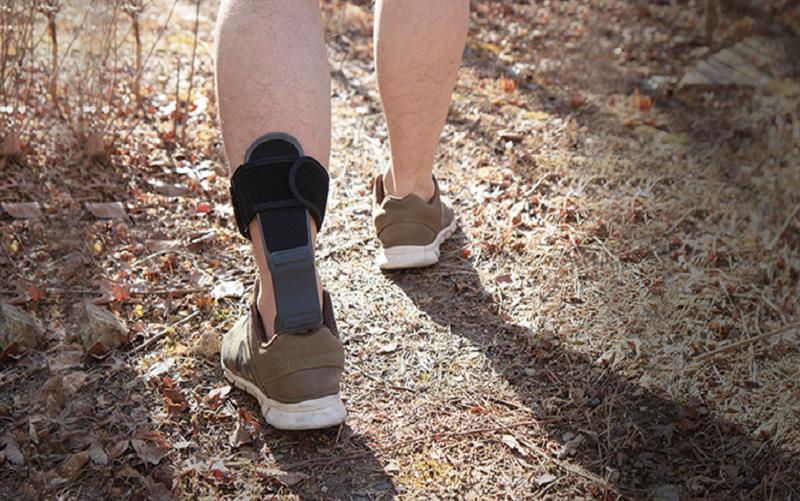
A situation in which you are unable to raise the ball of your feet is known as foot drop. Foot drop is a disease of the lower extremity that can be brought on by a number of neurological or orthopedic problems.Foot drop results from a failure to lift the forefoot or flex the ankle as a result of changes in muscle tone in the foot and leg.
Foot drop can make a person's foot "drop" or slide while they are walking. When the toes drag, it is simple to trip over objects on the ground, making the inability to effectively raise the foot off the ground a serious safety concern.
How can I get my foot descent better?
Foot drop can be unilateral or bilateral, mild to serious. Ankle foot orthoses are frequently used as the first course of treatment.(AFO brace).
For patients with drop foot hemiplegia disorder, ankle foot orthoses (AFOs) are frequently recommended to improve gait deviation and normalize walking patterns. Healthy people accomplish toe clearance primarily through functional lower limb shortening, which includes hip and knee flexion as well as ankle dorsiflexion. By the way, the abnormal movement of the knee and hip hike to compensate for the ankle movement is caused by a decrease in toe clearance of the affected foot caused by an ankle joint disability. It is a significant contributor to falls in people with foot drop condition.
People who have foot drop use compensatory motions to make up for their lack of foot control, such as excessive hip lift or excessive knee flexion. This pattern may cause discomfort or limitations in other bodily parts.
Numbness in the affected foot is a common symptom of foot drop, which makes it difficult to sense minute changes when walking on uneven surfaces and raises the risk of falling.
Management and Treatment of Foot Drop
Since foot drop is a symptom and not a disease, it may get better or even go away if the underlying problem is successfully treated. However, there are some situations where foot drop is irreversible and cannot be successfully treated.
In addition to the various treatments we'll discuss below, your patient can take a few easy but useful precautions to help keep them secure as they deal with foot drop.
They should exercise caution in the home by taking the following measures because foot drop raises the risk of tripping and falling:
- Keep clutter to a minimum on all levels.
- Do not use throw mats.
- Disconnect cables from walkways.
- Make sure that hallways and stairs are adequately illuminated.
- On the top and bottom levels of staircases, apply fluorescent tape.
Treatment Methods
Treatment for foot drop is based on the underlying reason and extent of the impairment. Standard therapy approaches that may occasionally be combined with one another include:
1. Physical exercise
Recovery from foot drop may benefit from physical treatment. The flexibility and power of the leg muscles can be increased with specific exercises. It may be advantageous to select a physical trainer who is familiar with foot drop and its causes.
2. Surgery
Several surgical options may be helpful if patients need a more rapid cure than orthotics or physical therapy can offer over time. These include:
- Tendon movement : In order to replace the tibialis anterior, it is necessary to direct a tendon that travels to a separate area of the foot toward the top of the foot.
- Fused ankles : To relieve the strain on the supporting muscles, the foot and ankle are fused during this procedure.
- Grafting or moving of nerves. By substituting healthy nerves for the damaged ones, this process repairs the nerves.
Foot-Ankle Orthotics
The ankle foot orthosis (AFO), which supports the foot by maintaining a 90-degree angle with the lower limb, is one frequently used device. To select the ideal AFO for each patient, we collaborate with a number of medical professionals. Since everyone is unique, the same foot drop support won't be advantageous for everyone.
When selecting an AFO brace for the therapy of foot drop, the following factors should be taken into account:
- Rigid or pliable :While softer braces are more comfortable and less likely to compromise skin health, rigid braces are more supportive.
- Solid or hinged :While solid braces fully support the foot and ankle, hinged braces enable users to continue using their ankle muscles.
- Prefabricated or built to order :Prefabricated options may be more suitable if they are only temporary, even though custom-made options are personalized and tailored to your patient's unique requirements and body structure.
- Outwardly obvious or easily concealed :Patients occasionally desire the least noticeable AFO brace feasible.
- Either more costly or cost-effective : Depending on insurance coverage and the kind of AFO required, AFO costs can vary significantly.